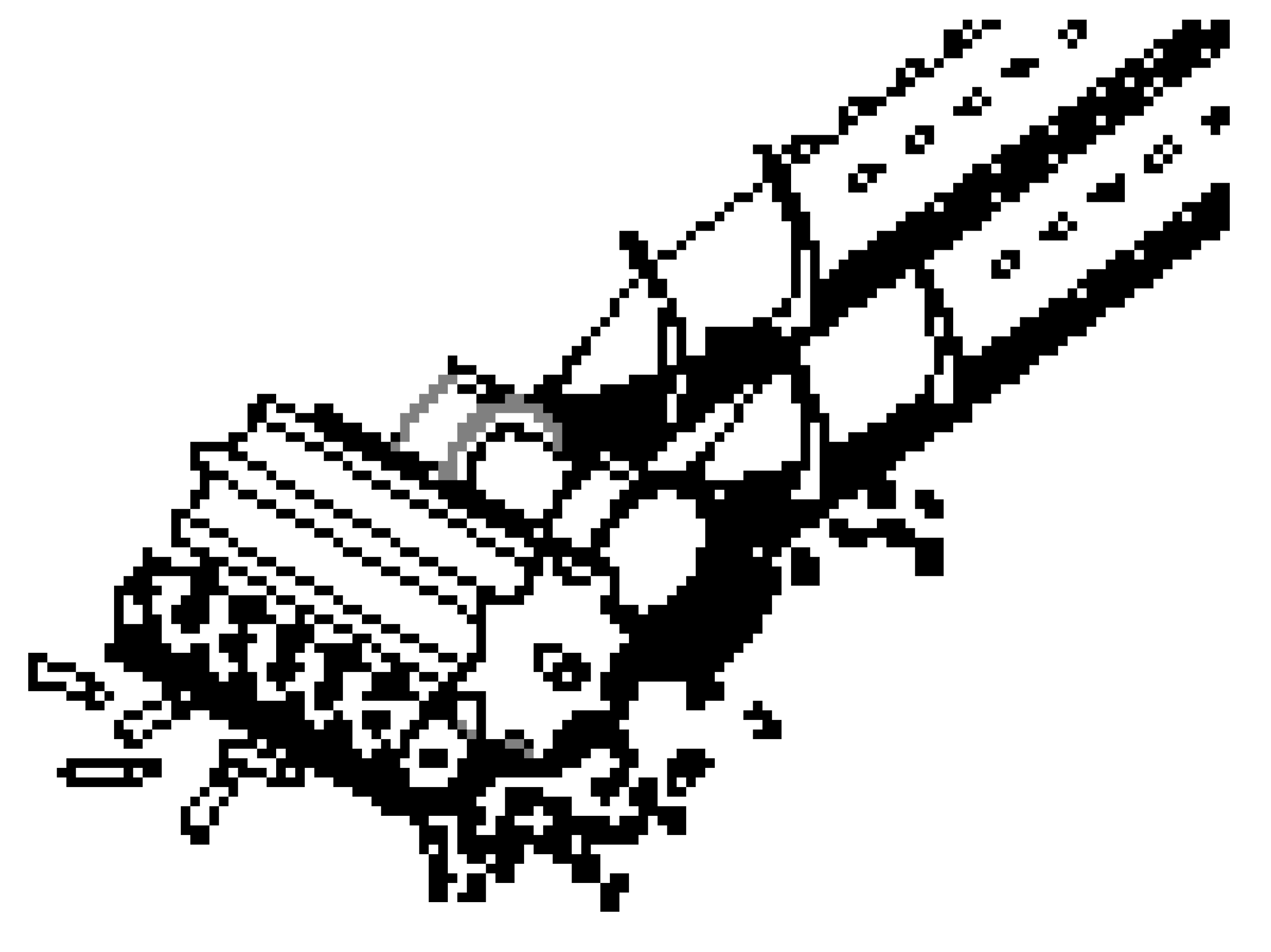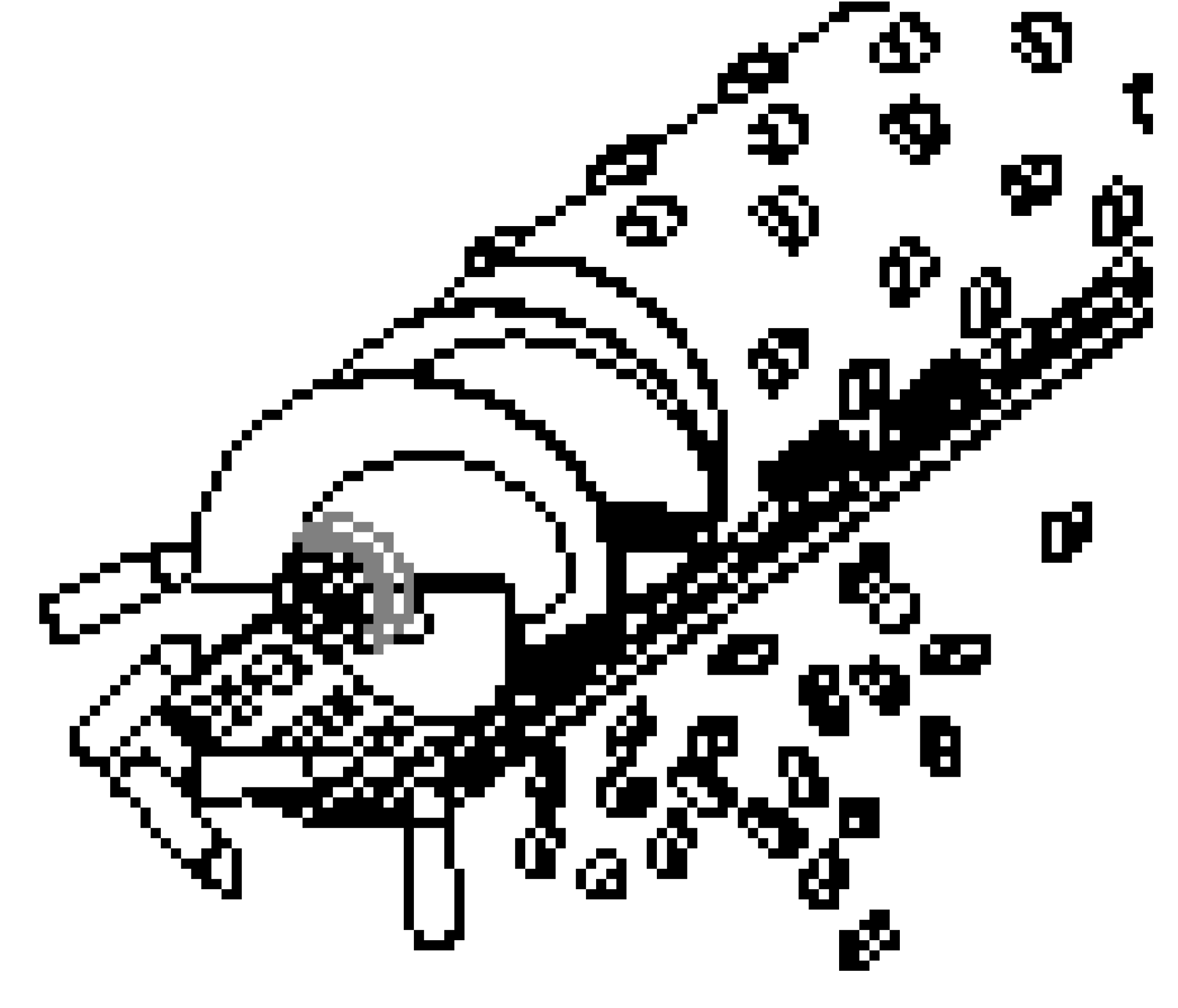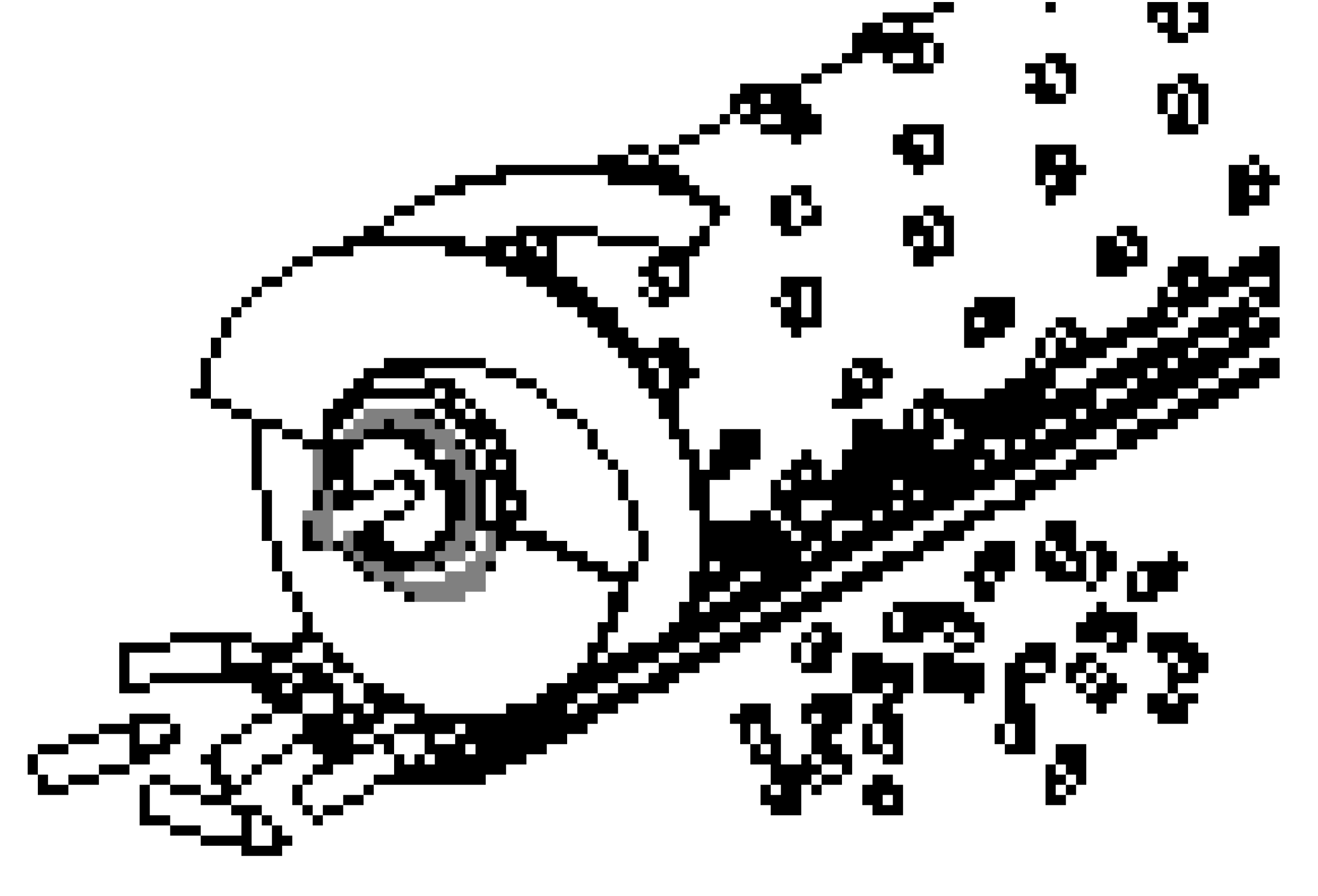Abstract
Maize is one of the most important economic crops in the world. The integrity of maize grains directly affects the economic value of the maize as a main commodity that depends on the percentage of grains broken (POGB) in mechanized harvesting. Decreasing grain processing breakage is key to achieving mechanical harvesting with high quality. It is difficult to ensure a low POGB, because it depends on different maize varieties, their moisture contents, threshing devices and harvester working speeds. In this paper, the effects of these factors on the POGB are investigated when the working speed of the harvester is 1.0 m·s−1, 1.5 m·s−1 and 2.0 m·s−1, respectively. The different threshing forms, including tangential-axial-flow (TAF), axial-flow with nail-tooth (AFN), axial-flow with rasp bar in big space (AFRBBS) and axial-flow with rasp bar in small space (AFRBSS), are summarized. The POGB of TAF was 5.4% and it was the lowest of four threshing devices when the working speed of the harvester was 1.0 m·s−1, which was suitable to thresh maize at a low working speed. Maize Demeiya No. 1 (DMYN1), XianDa205 (XD205), Demeiya No. 3 (DMYN3) and Hayu189 (HY189) were harvested at different harvester working speeds, and the POGB of maize DMYN1 was the lowest among the four maize varieties. The POGB increased with increases in the working speed of the harvester and the moisture content of the maize grains. The POGB reached a minimum value of 3.5% when maize XD205 with the lowest moisture content was harvested. The results can provide a reference for choosing the maize variety, its moisture content, the threshing device and the working speed of the harvester for decreasing grain processing breakage.
1. Introduction
Maize is one of the most important crops in the world [1]. It has become a basic material widely used in food, chemistry and forage. The comprehensive value of maize will continue to increase in the future [2,3,4]. The market competitiveness of maize can be improved by increasing the mechanized level of harvesting [5,6]. The efficiency of harvesting maize has been gradually improved with the continuous development of harvesting technology [7]. The percentage of grains broken (POGB) is a very important index in maize harvesting. It has been a focus of high-efficiency mechanized harvesting [8]. Moreover, a high POGB exists in the mechanized harvesting of maize grains. This problem not only reduces the grades of maize and its economic value, but also increases the cost of drying maize grains and poses serious challenges for safe storage [9].
Some scholars have analyzed the effect of some factors on the POGB. Wang and Li [10] summarized the key factors that resulted in a high POGB, including the planting patterns, the harvesting periods, the structures of the threshing device, the maize varieties and their moisture content. Gu et al. [11] investigated the effect of moisture content on the threshing performance and determined that the POGB increased with increasing moisture content. Waree, Somchai and Khwantri [12] studied the effects of the moisture content of maize, the rate of feed and the rotating speed of the cylinder on the threshing performance based on an axial-flow threshing device. Fan et al. [13] discovered the parameters affecting the POGB and showed that the POGB was significantly affected by the moisture content of the maize grains, followed by the rotating speed of the cylinder and the shape of the picking board, with the smallest effect being from the working speed of the harvester. Byg and Hall [14] discovered that the POGB was lowest in the threshing process when the moisture content of maize grains was 20% (wet basis). The strength of maize grains being broken and the force of maize threshed were mainly affected by the moisture content. Gao et al. [15] discovered that the characteristic of maize grains resisting breakage was improved significantly when the moisture content decreased. More robust maize varieties are usually bred to lower the POGB. The POGB was mainly affected by the rotating speed of the cylinder in the mechanized harvesting in [16]. The maize grains were also severely broken due to the excessive working speed of the harvester, which would increase the mass of maize fed in. Therefore, a suitable working speed of the harvester should be investigated to ensure high-quality harvesting.
There have also been studies on the structural parameters of the threshing device. Valdas et al. [17] added filler plates between the cylinder and rasp bars to improve the speed of maize feeding and the performance of grain separation. Then, the optimal form of filler plates installed was determined with tests. Qian et al. [18] compared the flexible threshing tooth with the traditional rigid pole-tooth and studied the multiple frictional contact dynamics of the flexible threshing tooth. It was shown that the impact force of the flexible tooth on maize grains was smaller and the POGB was lower. Yu et al. [19] simulated the process of maize threshing based on the discrete element method (DEM) and investigated the effects of the rotating speed of the cylinder and the rate of maize fed in on the threshing efficiency along the longitudinal direction of the cylinder.
There have also been studies on the physical characteristics of maize and the theories of kinematics and kinetics of maize grains. Petkevichiusa et al. [20] analyzed different methods of maize feeding and discovered that maize fed vertically in th e cylinder was optimum. Pužauskas et al. [21] established a mathematical model of maize ear threshing and obtained the value of contacting forces in grains by using the finite element method. Then, he used a concave crossbar to replace the traditional concave plate to reduce the effect of grains entrained by maize cobs and improve the percentage of grains threshed. The optimal declining angle of the adjacent concave plates was determined using the test. Miu and Kutzbach [22] analyzed and optimized the model of kinematics of maize in the axial-flow threshing device to guide future research. Miu and Kutzbach [23] revealed the threshing mechanism and established a model of the kinematics and kinetics of maize grains. The equations of the percentages of unthreshed grains, free grains and separated grains (cumulative and distribution) along the longitudinal direction of the threshing device were obtained. This research provided a reference for selecting parameters in the virtual test.
Maize is impacted and rubbed by the threshing device, which consists of the cylinder and the concave-bumper. Then, grains are threshed from the maize cobs and sieved through the gaps in the concave bumper [24]. The threshing forms are divided into two types. One is tangential-flow threshing, and the other is axial-flow threshing. Maize ears are fed tangentially into the cylinder in a tangential-flow threshing device. The threshing time is shorter, resulting in a poor separating performance and a high POGB. Maize ears are fed and separated with a spiral motion along the axis direction, which results in a longer threshing process in the axial-flow threshing device. Thus, the percentage of grain threshed would be higher and the POGB would be lower, but a higher power consumption would occur [25]. The tangential-flow threshing device is generally selected as a pre-threshing device. The axial-flow threshing device is the main threshing form due to the reasonable assembly space and better working performance.
The difficulty of high-efficiency harvesting is increased as various varieties of maize are planted on large-scale farms and harvested by different maize grain harvesters. Thus, a field test of the threshing performance is necessary. In this paper, the effects of different-variety maize, their moisture contents, threshing devices and working speeds of the harvester on the POGB were investigated. A suitable combination of these factors was obtained for threshing. The results can provide a reference to ensure a low POGB in mechanized harvesting.
2. Materials and Methods
2.1. Materials
The field test was carried out at the No. 852 Farm in Heilongjiang Province. The farm is the largest farm in China, and its area is 68,000 ha. The harvesting period is mainly concentrated from October to November. The test instruments included an electronic balance (Ruian Yingheng Electric Co., Ltd., Ruian, China, Arrw60 mode, 0.1 g), tape, stopwatch, grain moisture content measuring instrument (Kunshan Lugong Precision Instrument Co., Ltd., Lushan, China, ST-105A mode, 0.01%) and sampling bag. Maize XD205, DMYN1, DMYN3 and HY189 are planted widely on the farm. The harvest ages of the four maize varieties (XD205, DMYN1, DMYN3 and HY189) were from October to mid-October. The number of days to 50% silking of the four maize varieties was about 90 days [26]. The maize varieties are shown in Figure 1. Mature maize plants with uniform growth, no pests or diseases and no lodging were selected in the experimental field. The moisture content of the maize grains was measured before the test.
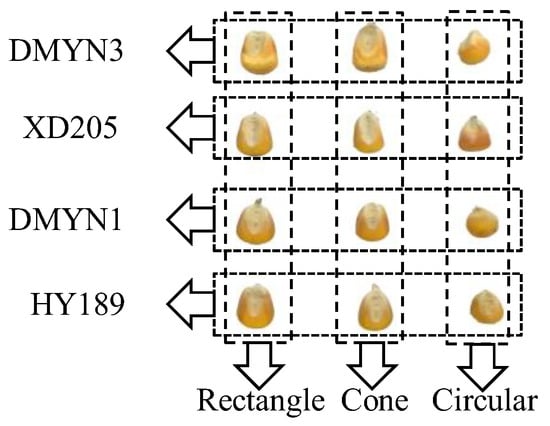
Figure 1.
Maize varieties.
Before harvest, all ears within 10 m of a single row in the experimental area were weighed. The mass of maize fed was calculated. The main planting patterns and physical characteristics of the different-variety maize are shown in Table 1.

Table 1.
Planting patterns and physical characteristics of different-variety maize.
2.2. Devices
The threshing devices of AFRBSS, AFN, AFRBBS and TAF were applied with LovolGK100 (Heilongjiang Agricultural machinery Co., LTD, Harbin, China), John DeereS660 (Shaanxi Kaidrexin agricultural Machinery Co., LTD, Shanxi, China), Case7088 (Case New Holland Industrial Machinery Co., LTD, Harbin, China) and Claas770 (Kole agricultural Machinery Co., LTD, Beijing, China), respectively. The four harvesters were chosen to measure the performance of these threshing devices. The eight-row picking head was designed identically to be used in each combine. The working harvesters are shown in Figure 2. The working speeds of the harvesters, obtained by measuring their routine working speeds, ranged from 1.0 m·s−1 to 2.0 m·s−1.
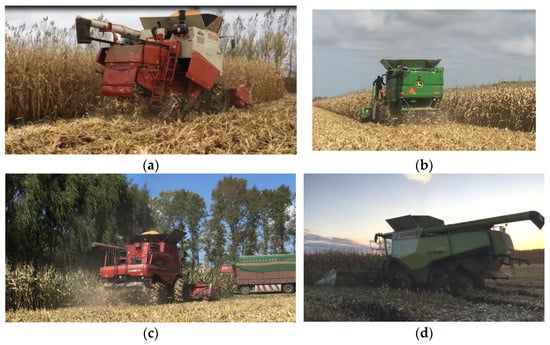
Figure 2.
LovolGK100 (a), John DeereS660 (b), Case7088 (c), and Claas770 (d) at work.
The different threshing devices were also combined to create a new form to improve threshing performance. For example, the multistage threshing device is composed of the tangential-flow cylinder and the axial-flow cylinder. The tangential-flow cylinder is used as a pre-separation device, and the rear part of this device is connected to a single axial-flow or multi axial-flow cylinder. A single longitudinal axial-flow threshing device is widely used in maize grain combine harvesters. The Claas770 threshing device is designed based on the former. The John DeereS660, Case7088 and LovolGK100 threshing devices are all designed based on the latter. The structural parameters and parts of the four threshing devices are shown in Table 2.

Table 2.
Forms of different threshing devices.
2.3. Methods
To investigate the effects of the maize variety, the threshing device and the working speed of the harvester on the POGB, field tests were conducted, and each test was replicated three times. Plots with similar terrain were selected to minimize the effects of the different working environments on the threshing performance. The test was conducted in October at the No. 852 Farm in Heilongjiang Province. The moisture content of grains was measured from 10 a.m. to 11 a.m. as the moisture content of grains is stable from 9 a.m. to 3 p.m. Then, moisture contents of 22.61%, 26.03% and 30.49% (wet basis) were obtained by using the grain moisture content measuring instrument. As the moisture content of maize grains is uncontrollable, maize with standard deviations of moisture content ranging from −1% to 1% at each level was selected for testing.
The distance of 10 m was measured using the tape along the working direction of the harvester. The distance of the acceleration phase of the harvester was reserved to ensure that the maize could be harvested with a stable working speed during the field test. The driver fixed the working speeds of the harvester at 1.0 m·s−1, 1.5 m·s−1 and 2.0 m·s−1 by controlling the intelligent operating handle. The reference values of the rotating speed of the cylinder and the gap between the cylinder and counter-bumper were provided by the intelligent systems of the four harvesters for harvesting maize. The ranges of rotating speeds of the cleaning devices and the harvester fans were 280~320 r·min−1 and 1000~1200 r·min−1, respectively. To investigate the threshing performance of the different devices, the rotating speeds of the cylinders of the four harvesters should be unified. The rotating speed of the cylinders was 380 r·min−1, which is suitable for the four harvesters to thresh maize. The desired value of the rotating speed of the cylinder was set by controlling the intelligent operating handle. The parameter of counter-bumper were set based on the intelligent operating system of the four harvesters and the experience of manipulators in harvesting. The gap between the cylinder and the counter-bumper ranged from 70 mm to 30 mm. To ensure the percentage of grains removed, a minimum gap between the cylinder and counter-bumper of 30 mm was selected to conduct a single factor test to investigate the percentage of grains broken. The peripheral speeds of the TAF, AFN, AFRBBS and AFRBSS were 8.85 m·s−1, 15.16 m·s−1, 15.16 m·s−1 and 16.59 m·s−1, respectively, based on Equation (1).
where v is the peripheral speed of the cylinder (m·s−1), n is the rotating speed of the cylinder (r·min−1) and D is the diameter of the cylinder (mm).
v = nπD/60,000
The mass of maize fed can be calculated as follows:
where Q is the mass of maize fed (kg/s), M is the ear mass per plant (kg), L is the working distance of the harvester (m), S is the plant spacing (m), H is the number of rows of maize plants harvested by the harvester and t is the working time of the harvester (s).
2.4. Index
Based on “Test Methods for Maize Harvesting Machinery” (GB/T21961-2008) and “Terminology for Combines and Grain Harvesting” (S343.4-2015), the POGB was chosen as the experimental index. At the end of each test, 1000 g of grains were randomly selected from the grain box, and the broken grains were separated and weighed. The two-way ANOVA analytical method was employed to examine the interaction between different factors using Design-Expert software.
The POGB can be calculated using Equation (3).
where m1 is the total mass of maize grains (kg), m2 is the mass of the broken grains (kg) and y1 is the percentage of grains broken (%).
3. Results and Analysis
3.1. Effect of Threshing Devices on the POGB
The effect of the different threshing devices on the POGB was investigated based on maize XD205 with a moisture content of 26.03%. The schematic presentation of quantities of grains broken for the XD205 maize variety based on the different threshing devices harvested at a working speed of 1.0 m·s−1 is shown in Figure 3.
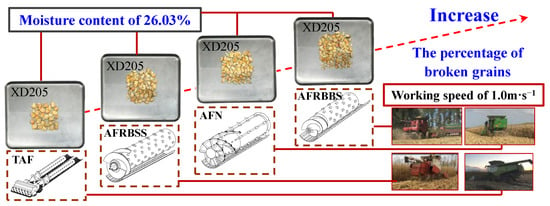
Figure 3.
Schematic presentation of grains broken after threshing by different devices.
The POGB of the three threshing devices (TAF, AFRBBS and AFN) increased with the increasing working speed of the harvester. However, the POGB of AFRBSS first decreased and then increased with the increasing working speed of the harvester. The lowest POGB of TAF at the harvester working speed of 1.0 m·s−1 was 5.4%, which was 0.9%, 0.5% and 1.6% lower than that of AFN, AFRBSS and AFRBBS, respectively. The highest POGB of AFN was 8.6% at the working speed of 2.0 m·s−1, which was 0.2%, 1.5% and 1.1% higher than that of AFN, AFRBSS and AFRBBS, respectively. The results of the POGB of the different threshing devices are shown in Table 3.

Table 3.
POGB of different threshing devices (%).
The data were subjected to ANOVA to determine the effect of threshing devices on the POGB, as shown in Table 4. A 95% confidence interval was chosen during the analysis of variance. Based on the result, it was established that the significance of the model was highly significant (p < 0.01), which implied that the model provided a good fit for the experimental data. The p-values for both the main effect (threshing devices and working speed) and the interaction term were less than 0.01, which implied that both of them had a highly significant impact on POGB.

Table 4.
ANOVA Table for POGB (%) from data in Table 3.
The mass of maize fed was small at a low harvester working speed. A portion of the grains are threshed and sieved in the tangential-flow threshing device of TAF. A small amount of grains entering the twin longitudinal axial-flow threshing device and the low peripheral speed of the cylinder result in a weak hitting impact on the maize and a lower POGB. The mass of maize fed increased at a high harvester working speed. The sieving performance of the tangential-flow threshing device decreased due to the collision and accumulation of the grains, and a higher POGB occurred. The number of grains entering the twin longitudinal axial-flow threshing device increased and the hitting impact of this device was greater than that of the single longitudinal axial-flow cylinder. Therefore, the POGB in TAF was the lowest of the four threshing devices at a working speed of 1.0 m·s−1. The POGB in TAF was the highest among the four threshing devices at a working speed of 2.0 m·s−1.
The POGB of AFRBBS was the highest among the four threshing devices at the working speed of 1.0 m·s−1. The reason is that a great length and a high peripheral speed of AFRBBS led to a longer threshing time of maize and a stronger impact. However, a better threshing performance existed in AFRBBS to thresh maize, because of the bigger internal space, when the mass of maize fed was higher. Therefore, the change in the POGB in AFRBBS was small at different working speeds of the harvester. The effect of the nail-tooth hitting was greater than that of the rasp bars under the same peripheral speed of the cylinder when the mass of maize fed increased. Therefore, the POGB in AFN was higher than that in AFRBBS at the working speed of 2.0 m·s−1. The POGB of AFRBSS was lowest among the four threshing devices at the working speed of 2.0 m·s−1 because of the shortest length of the cylinder of AFRBSS, which indicates that the POGB would decrease by shortening the time of maize threshed appropriately when the mass of maize fed is bigger.
3.2. Effect of Maize Varieties on the POGB
The mass of maize fed is one of the main factors that affects the performance of the threshing device. There are differences in the plant spacing and the ear mass among the four-variety maize. The plant spacing of DMYN1 was the narrowest, at 179 mm, and the ear mass of XD 205 was the heaviest at 259.61 g, as shown in Table 2. The narrower the plant spacing, the greater the number of maize plants harvested per second at the same working speed of the harvester. The heavier the ear mass, the higher mass of maize harvested per second at the same working speed of the harvester, which resulted in the increase of the mass of maize fed. A higher mass of maize fed would also be produced by a higher harvester working speed.
The mass of the four-variety maize fed at the different working speeds was ensured by Equation (2) and shown in Table 5.

Table 5.
Mass of the four-variety maize fed at different working speeds based on AFN.
The effect of the different-variety maize with a moisture content of 26.03% on the POGB was investigated based on the AFN. The schematic presentation of grains broken using the nail-tooth threshing device for the different-variety maize harvested at a working speed of 1.0 m·s−1 is shown in Figure 4.
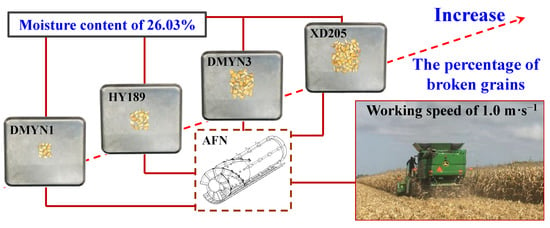
Figure 4.
Schematic presentation for different-variety maize grains broken.
The POGB of the four-variety maize increased with increasing harvester working speeds. The reason was that increased harvester working speeds result in an increase in the mass of maize fed. The POGB would be higher when the threshing strength of the cylinder increased [27]. The mass of XD205 fed was the highest among the four varieties of maize at the different harvester working speeds, which resulted in the highest POGB of XD205. The lowest POGB of DMYN1 was 2.0% at the harvester working speed of 1.0 m·s−1, which was 4.3%, 2.8% and 0.3% lower than that of XD205, DMYN3 and HY189, respectively. The highest POGB of DMYN1 was 4.8% at the harvester working speed of 2.0 m·s−1, which was 3.6%, 1.9% and 0.3% lower than that of XD205, DMYN3 and HY189, respectively. The results of the POGB of the different varieties of maize are shown in Table 6.

Table 6.
POGB of different varieties of maize based on the AFN (%).
The data were subjected to ANOVA to determine the effect of threshing devices on the POGB, as shown in Table 7. A 95% confidence interval was chosen during the analysis of variance. Based on the result, it was established that the significance of the model was highly significant (p < 0.01), which implied that the model provided a good fit for the experimental data. The p-value for the main effect (variety and working speed) was lower than 0.01, which implied that both of them had a highly significant impact on POGB. The p-value for the interaction term was more than 0.1, which implied that it had a non-significant impact on POGB.

Table 7.
ANOVA Table for POGB (%) from data in Table 6.
The threshing performance was affected by the mass of maize fed. The masses of DMYN1 and HY189 fed were smaller than those of XD205 and DMYN3 fed at different harvester working speeds. Therefore, the POGB of DMYN1 and HY189 were smaller than those of XD205 and DMYN3. There were similar physical characteristics, such as the size, shape and hardness of the maize planted in the same accumulated temperature zone, which resulted in a small difference in the POGB of maize DMYN1 and HY189. A better anti-breaking characteristic existed in the maize DMYN1, as it was horny maize [28]. Therefore, the POGB of maize DMYN1 was the lowest of the four maize varieties, with a moisture content of 26.03%.
3.3. Effect of the Moisture Content of Maize Grains on the POGB
The effect of different moisture contents of the maize grains on the POGB was investigated based on the AFN and maize XD205. The quantities of broken grains with different moisture contents harvested at a working speed of 1.0 m·s−1 are shown in Figure 5.
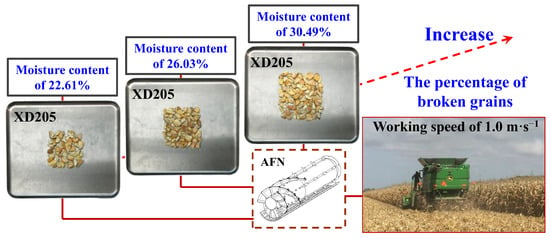
Figure 5.
Schematic presentation of different moisture contents of the maize grains.
The POGB increased with the increasing moisture content of the maize grains [29]. The reason was that a low anti-breaking characteristic existed in the maize grains with a high moisture content [30]. Therefore, the hitting effect of the threshing device on the maize grains would be greater, and a higher POGB would occur. The results of the POGB at different maize grain moisture contents are shown in Table 8.

Table 8.
POGB of different moisture contents of the maize grains based on the AFN and maize XD205 (%).
The POGB of maize XD205 with a moisture content of 22.61% was 3.5%, which was 2.8% and 3.7% lower than that of maize XD205 with moisture contents of 26.03% and 30.49%, respectively, at the harvester working speed of 1.0 m·s−1. The POGB of maize XD205 with a moisture content of 22.61% was 6.9%, which was 1.5% and 3.4% lower than that of maize XD205 with moisture contents of 26.03% and 30.49%, respectively, at the harvester working speed of 2.0 m·s−1.
The data were subjected to ANOVA to determine the effect of threshing devices on the POGB, as shown in Table 9. A 95% confidence interval was chosen during the analysis of variance. Based on the result, it was established that the significance of the model was highly significant (p < 0.01), which implied that the model provided a good fit for the experimental data. The p-values for the main effects (moisture content and working speed) were less than 0.01, which implied that both of them had a highly significant impact on POGB. The p-value for interaction term was more than 0.1, which implied that it had a non-significance impact on POGB.

Table 9.
ANOVA Table for POGB (%) from data in Table 8.
4. Discussion
The POGB of Maize DMYN1 harvested by Case4088 was 1.94% [31], and the lowest POGB of Maize DMYN1 harvested by John DeereS660 was 2.0% in this paper, which indicated that a good adaptation to different harvesters existed in Maize DMYN1. There was a significant positive correlation between the mass of maize fed determined by the harvester working speed and the POGB [16]. A small mass of maize fed should be controlled to reduce the POGB in harvest. There was a significant positive correlation between the moisture content of the maize grain and the POGB [15]. It is suitable to harvest maize when its moisture content is 22.61% at a harvester working speed of 1.0 m·s−1. Reference [12] posits that it is suitable to thresh maize grain when its moisture content is 22–23%, which coincides with the conclusion in this paper.
Difficulties in harvesting are increased due to the uncontrollability of the moisture content. From the perspective of agronomy, it could be considered that a new maize variety would be cultivated to achieve a high yield at a low moisture content. In the harvesting period, the harvesters usually work at a high speed to improve the harvesting efficiency. However, maize grains with a high moisture content are severely broken under these conditions. Maize can be harvested in the frost period when the moisture content of the maize grains is lower to reduce the POGB and maintain a high harvesting efficiency. From the perspective of agricultural machinery, some new threshing devices could be developed for reducing the POGB, such as a threshing device with monitoring and controlling mass feeding featured [32,33], a differential-speed threshing device [34], a combined-spiral threshing device [35], a staggered threshing device [36], the flexible threshing device [37] and so on. Based on these new threshing devices, a large number of field experiments should be carried out to test their adaptability to different maize varieties and moisture contents to ensure that they could be popularized and applied to the combine harvester as soon as possible. In short, agronomy and agrology need to be integrated to reduce the POGB for a high yield.
Experts and scholars have mostly studied threshing parts. These studies are limited due to various factors, such as the status of maize growth, the patterns of maize planting and the environments of maize harvesting. Therefore, the effect of these factors on POGB should be fully considered and analyzed in future studies. In this paper, only the effect of the different threshing devices on performance was investigated. Other performances, such as those of the cleaning device, the copping device and the picking device, should be investigated in future research.
5. Conclusions
The working principles of the four threshing devices were summarized. The effect of the four threshing devices on the percentage of grains broken was investigated based on maize XianDa205 with a moisture content of 26.03%. During a sufficient harvesting period, a low working speed of the harvester should be maintained for a low percentage of grains broken. To reduce the percentage of grains broken, the tangential-axial-flow should be employed to harvest maize at a harvester working speed of 1.0 m·s−1, and the axial-flow with the rasp bar in small space should be employed at the harvester working speed of 2.0 m·s−1. A higher stability exists in the axial-flow with the rasp bar in a big space for threshing maize at various working speeds. This threshing device should be employed to reduce the percentage of grains broken when the harvester working speed is changing.
The percentage of grains broken in the four varieties of maize increased with increases in the harvester working speed. The lowest percentage of grains broken in maize Demeiya No. 1 was 2.0% at the harvester working speed of 1.0 m·s−1, which was 4.3%, 2.8% and 0.3% lower than that of maize XianDa205, Demeiya No. 3 and Hayu189, respectively. Maize Demeiya No. 1 is the most suitable of the four varieties of maize harvested in terms of axial-flow with nail-tooth.
The percentage of grains broken increased with the increasing moisture content of the maize grains. It is suitable to harvest maize when its moisture content is 22.61% at the harvester working speed of 1.0 m·s−1. These findings provide a reference for decreasing grain processing breakage in mechanized harvesting.
Author Contributions
X.F.: Investigation, Theoretical analysis, Data curation, Funding acquisition, Writing, original draft. L.W.: Investigation, Theoretical analysis, Supervision, Writing. S.B.: Methodology, Writing—review and editing. B.W.: Writing—review and editing. Z.M.: Investigation. Y.G.: Investigation. All authors have read and agreed to the published version of the manuscript.
Funding
This work was supported financially by the National Natural Science Foundation of China (52075091) and Heilongjiang Postdoctoral Foundation (LBH-Z20114).
Data Availability Statement
Not applicable.
Acknowledgments
The authors would like to thank their schools and colleges, as well as the funding providers of the project. All support and assistance are sincerely appreciated.
Conflicts of Interest
The authors declare that they have no known competing financial interest or personal relationship that could have appeared to influence the work reported in this paper.
References
- Yang, L.Q.; Wang, W.Z.; Zhang, H.M.; Li, L.H.; Wang, M.M.; Hou, M.H. Improved Design and Bench Test Based on Tangential Flow-Transverse Axial Flow Maize Threshing System. Trans. Chin. Soc. Agric. Eng. 2018, 34, 35–43. (In Chinese) [Google Scholar]
- Yang, L.; Cui, T.; Qu, Z.; Li, K.H.; Yin, X.W.; Han, D.D.; Yan, B.X.; Zhao, D.Y.; Zhang, D.X. Development and Application of Mechanized Maize Harvesters. Int. J. Agric. Biol. Eng. 2016, 9, 15–28. [Google Scholar] [CrossRef]
- Hao, J.F.; Han, Z.D.; Liu, G.M.; Li, X.D. Research Status and Development Trend of Cleaning Device of Corn Thresher. J. Anhui Agric. Sci. 2016, 44, 322–324. (In Chinese) [Google Scholar] [CrossRef]
- Chen, Y.J.; Wang, Q.Q.; Xiang, Y. Analysis on the Status, Superiority and Self-Sufficiency Ratio of Maize in China. Chin. J. Agric. Resour. Reg. Plan. 2019, 40, 7–16. (In Chinese) [Google Scholar]
- Guo, Y.Q.; Xu, W.J.; Wang, K.R.; Chai, Z.W.; Xie, R.Z.; Hou, P.; Ming, B.; Li, S.K. Actuality and Factors Influencing Farmer Adoption of Mechanized Harvesting in Typical Maize Ecoregions. Chin. J. Eco-Agric. 2021, 29, 1964–1972. (In Chinese) [Google Scholar] [CrossRef]
- Wang, K.R.; Li, L.L.; Gao, S.; Wang, L.Z.; Huang, Z.F.; Xie, R.Z.; Ming, B.; Hou, P.; Xue, J.; Zhang, G.Q.; et al. Analysis of Main Quality Index of Corn Harvesting with Combine in China. Acta Agron. Sin. 2021, 47, 2440–2449. (In Chinese) [Google Scholar]
- Cui, T.; Fan, C.L.; Zhang, D.X.; Yang, L.; Li, Y.B.; Zhao, H.H. Research Progress of Maize Mechanized Harvesting Technology. Trans. Chin. Soc. Agric. Mach. 2019, 50, 1–13. (In Chinese) [Google Scholar] [CrossRef]
- Song, J.Q.; Lu, D.W.; Zhang, Y.Y.; Li, Y.J.; Dong, W.H.; Sun, H.C.; Lu, L.Y.; Niu, Y.F.; Zhang, X.H.; Zhang, P. Relationship Between Corn Grain Moisture and Grain Breaking Rate Threshed by Machine. J. Hebei Agric. Sci. 2018, 22, 27–31. (In Chinese) [Google Scholar] [CrossRef]
- Yang, W.; Li, J.D.; Fang, X.F.; Shang, S.Q.; Du, W.W. Domestic and Foreign Current Situation and Development Trend of Seeding Mechanization in Maize Breeding. J. Agric. Eng. 2018, 8, 9–15. (In Chinese) [Google Scholar]
- Wang, K.R.; Li, S.K. Progresses in Research on Grain Broken Rate by Mechanical Grain Harvesting. Sci. Agric. Sin. 2017, 50, 2018–2026. (In Chinese) [Google Scholar] [CrossRef]
- Gu, R.L.; Huang, R.; Jia, G.Y.; Yuan, Z.P.; Ren, L.S.; LI, L.; Wang, J.H. Effect of Mechanical Threshing on Damage and Vigor of Maize Seed Threshed at Different Moisture Contents. J. Integr. Agric. 2019, 18, 1571–1578. [Google Scholar] [CrossRef]
- Waree, S.; Somchai, C.U.; Khwantri, S. Effects of Operating Factors for An Axial-Flow Corn Shelling Unit on Losses and Power Consumption. Agric. Nat. Resour. 2016, 50, 421–425. [Google Scholar] [CrossRef]
- Fan, G.C.; Wang, H.X.; Ji, J.J.; Cao, W.H.; Liu, H.X.; Hao, J.K.; Chen, D.R.; Zhou, Z.E.; Wang, S.H. Analysis of Influence Factor on Seed Damage Rate and Loss Rate during Picking Corn-Cob. Trans. Chin. Soc. Agric. Eng. 2002, 18, 72–74. (In Chinese) [Google Scholar] [CrossRef]
- Byg, D.M.; Hall, G.E. Corn Losses and Kernel Damage in Field Shelling of Corn. Trans. ASAE 1968, 11, 164–166. [Google Scholar] [CrossRef]
- Gao, L.X.; Li, F.; Zhang, X.W.; Zhang, Y.L.; Liu, X.; Jiao, W.P. Mechanism of Moisture Content Affect on Corn Seed Threshing. Trans. Chin. Soc. Agric. Mach. 2011, 42, 92–96. (In Chinese) [Google Scholar]
- Qu, Z.; Zhang, D.X.; Yang, L.; Zhang, T.L.; Wang, Z.D.; Cui, T. Experiment on Feed Rate and Cylinder Speed of Longitudinal Axial Flow Threshing and Separating Device for Maize. Trans. Chin. Soc. Agric. Mach. 2018, 49, 58–65. (In Chinese) [Google Scholar] [CrossRef]
- Valdas, K.; Dainius, S.; Albinas, A.; Aurelija, K.; Darius, J. Corn Ear Threshing Performance of Filler-Plate-Covered Threshing Cylinders. Mechanics 2017, 23, 714–722. [Google Scholar] [CrossRef]
- Qian, Z.J.; Jin, C.J.; Zhang, D.G. Multiple Frictional Impact Dynamics of Threshing Process between Flexible Tooth and Grain Kernel. Comput. Electron. Agric. 2017, 141, 276–285. [Google Scholar] [CrossRef]
- Yu, Y.J.; Fu, H.; Yu, J.Q. DEM-Based Simulation of the Corn Threshing Process. Adv. Powder Technol. 2015, 26, 1400–1409. [Google Scholar] [CrossRef]
- Petkevichiusa, S.; Shpokasa, L.; Kutzbachb, H.D. Investigation of the Maize Ear Threshing Process. Biosyst. Eng. 2008, 99, 532–539. [Google Scholar] [CrossRef]
- Pužauskas, E.; Steponavičius, D.; Jotautienė, E.; Petkevičius, S. Substantiation of Concave Crossbars Shape for Corn Ears Threshing. Mechanics 2016, 22, 553–561. [Google Scholar] [CrossRef]
- Miu, P.I.; Kutzbach, H. Mathematical Model of Material Kinematics in An Axial Threshing Unit. Comput. Electron. Agric. 2007, 58, 93–99. [Google Scholar] [CrossRef]
- Miu, P.I.; Kutzbach, H. Modeling and Simulation of Grain Threshing and Separation in Threshing Units—Part I. Comput. Electron. Agric. 2008, 60, 96–104. [Google Scholar] [CrossRef]
- Srivastava, A.K.; Goering, C.E.; Rohrbach, R.P.; Buckmaster, D.R. Engineering Principles of Agricultural Machines. Trans. ASABE 1993, 6, 403–435. [Google Scholar] [CrossRef]
- Stout, B.A.; Cheze, B.C. Handbook of Agricultural Engineering, Volume III: Plant Production Engineering. Trans. ASABE 1999, 311–347, 376–380. [Google Scholar] [CrossRef]
- Wang, X.; Li, X.; Gu, J.; Shi, W.; Zhao, H.; Sun, C.; You, S. Mapping of Phenological Traits in Northeast China Maize (Zea mays L.). Agronomy 2022, 12, 2585. [Google Scholar] [CrossRef]
- He, K.; Wang, Q.; Geng, D.Y.; Jin, C.Q.; Zhu, J.G.; Zhang, M.Y. Simulation and Analysis of Flexible Threshing Cylinder of Corn. J. Chin. Agric. Mech. 2018, 39, 53–58. (In Chinese) [Google Scholar] [CrossRef]
- Zhang, W.X.; Wang, K.R.; Xie, R.Z.; Hou, P.; Ming, B.; Liu, C.W.; Xiao, C.H.; Zhang, G.Q.; Chen, J.L.; Yang, J.J.; et al. Relationship between Maize Grain Broken Rate and Moisture Content as well as the Differences among Cultivars. J. Maize Sci. 2018, 26, 74–78. (In Chinese) [Google Scholar] [CrossRef]
- Liu, F.H.; Wang, K.R.; Li, J.; Wang, X.M.; Sun, Y.L.; Chen, Y.S.; Wang, Y.H.; Han, D.S.; Li, S.K. Factors Affecting Corn Mechanically Harvesting Grain Quality. Crops 2013, 4, 116–119. (In Chinese) [Google Scholar] [CrossRef]
- Cai, C.J.; Chen, Z.; Han, Z.D.; Liu, G.M.; Zhang, Z.L.; Hao, J.F. Study on Relationship of Biomechanical Characteristics of Corn Seed and Threshing Performance. J. Agric. Mech. Res. 2017, 39, 192–196. (In Chinese) [Google Scholar] [CrossRef]
- Li, S.K.; Wang, K.R.; Xie, R.Z.; Li, L.L.; Ming, B.; Hou, P.; Chu, Z.D.; Zhang, W.X.; Liu, C.W. Grain Breakage Rate of Maize by Mechanical Harvesting in China. Crops 2017, 2, 76–80. (In Chinese) [Google Scholar] [CrossRef]
- Fan, C.L.; Zhang, D.X.; Yang, L.; Cui, T.; He, X.T.; Zhao, H.H.; Dong, J.Q. Development and Performance Evaluation of a Guide Vane Inclination Automatic Control System for Corn Threshing Unit Based on Feedrate Monitoring. Comput. Electron. Agric. 2022, 194, 106745. [Google Scholar] [CrossRef]
- Song, Z.C.; Diao, P.S.; Pang, H.X.; Zhao, D.B.; Miao, H.Q.; Li, X.W.; Yang, D.Z. Design and Experiment of Threshing and Separating Device of Corn Grain Harvester. J. Agric. Eng. 2022, 66, 182–190. [Google Scholar]
- Zhou, X.; Wang, Z.M.; Tian, L.Q.; Su, Z.; Ding, Z. Innovative Design and Performance Test of Threshing-separating Device for Horizontal Axial-flow Combine Harvester. J. Agric. Eng. 2022, 67, 497–508. [Google Scholar]
- Li, X.Y.; Du, Y.F.; Guo, J.L.; Mao, E.R. Design, Simulation, and Test of a New Threshing Cylinder for High Moisture Content Corn. J. Appl. Sci. 2020, 10, 4925. [Google Scholar] [CrossRef]
- Li, X.P.; Zhang, W.T.; Wang, W.Z.; Huang, Y. Design and Test of Longitudinal Axial Flow Staggered Millet Flexible Threshing Device. Agriculture 2022, 12, 1179. [Google Scholar] [CrossRef]
- Li, X.P.; Zhang, W.T.; Xu, S.D.; Du, Z.; Ma, Y.D.; Ma, F.L.; Liu, J. Low-Damage Corn Threshing Technology and Corn Threshing Devices: A Review of Recent Developments. Agriculture 2023, 13, 1006. [Google Scholar] [CrossRef]
Disclaimer/Publisher’s Note: The statements, opinions and data contained in all publications are solely those of the individual author(s) and contributor(s) and not of MDPI and/or the editor(s). MDPI and/or the editor(s) disclaim responsibility for any injury to people or property resulting from any ideas, methods, instructions or products referred to in the content. |
© 2023 by the authors. Licensee MDPI, Basel, Switzerland. This article is an open access article distributed under the terms and conditions of the Creative Commons Attribution (CC BY) license (https://creativecommons.org/licenses/by/4.0/).
